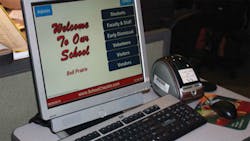School Security: Ensuring Access Control
Stringent security measures that lock down buildings, deny access to visitors and restrict movement on a campus might make some campuses safer, but it wouldn't be such a great environment for learning.
"Measures to turn our public and private schools into veritable fortresses with strict access controls are often unacceptable to the school authorities, as they are to the communities," the U.S. Department of Homeland Security's Primer to Design Safe School Projects in Case of Terrorist Attacks and School Shootings states.
But in today's world, there have been terrorist attacks and school shootings, so education administrators must decide on where and when access control is needed in their facilities. The Homeland Security primer, which defines access control as "any combination of barriers, gates, electronic security equipment or guards that can deny entry to unauthorized personnel or vehicles," provides some guidance for school security personnel.
One of the most threatening scenarios for a school community is the presence of a shooter on a campus or in a facility. An effective access-control system may help an education institution prevent violence or minimize its impact.
"Ideally, access-control systems should keep shooters out of a building completely, but in case a shooter manages to penetrate a building, the systems should include the ability to close and secure doors remotely, and thereby limit access to vulnerable targets," the primer says. "Limited access forces a shooter to spend more time searching for targets, giving the building occupants more time to evacuate to a safe area or seek cover in safe rooms. The delay also allows response forces more time to arrive on the scene to neutralize the threat or reduce casualties. Such systems also have the potential to trap the shooter in a specific area, increasing the chances of a positive outcome with no injuries. Immediate video assessment may give the staff the ability to notify law enforcement of an emergency and identify the exact location of the threat."
Homeland Security recommends that a school access-control system should incorporate these characteristics:
-
Visitors entering or leaving a school should be directed to a single control point and required to pass directly through to administration reception area.
-
The main entry area should be positioned so school personnel can monitor lobby doors, stairwells and perpendicular hallways without any obstructions. If the administrative area is on an exterior wall, office personnel also may help monitor outside areas, such as visitor parking and dropoff areas. Some schools may opt to install video surveillance of the lobby area to enhance security.
-
Access to classrooms and other interior spaces also should be controlled to protect against intruders. Doors to classrooms, offices, libraries, and other rooms frequently used by students should have access-control measures that prevent or delay access. The materials used to construct the doors and walls should be difficult to penetrate quickly.
-
Schools should insist on verifying the identity of service personnel, including maintenance personnel seeking access to utilities, alarm systems, communications systems and related maintenance locations, and vendors.
Schools should keep detailed and accurate records of service and delivery personnel, including a log to record the full names, organization name, vehicle information and other identification information of visitors.
-
Video surveillance at school entrances makes access control in schools practical without requiring a security person to be stationed at the entrance. An intercom and remote control of the door lock enables staff members in the main office to monitor the locked entrances. Many schools use this approach, but it may be less effective during the heavy traffic at morning arrival time and when groups of students return from activities outside the building.
-
Entry inspections to prevent concealed weapons or other contraband from entering a building is a common element of access control in non-educational settings, but in most cases is impractical for schools, the primer says.
"Routine entry inspections…would be extremely difficult to carry out within the context of normal daily routines. Entry inspections are intrusive, time-consuming, and impractical in the school setting."
About the Author
Mike Kennedy
Senior Editor
Mike Kennedy, senior editor, has written for AS&U on a wide range of educational issues since 1999.
